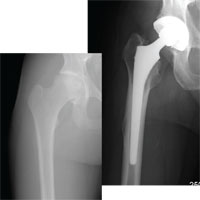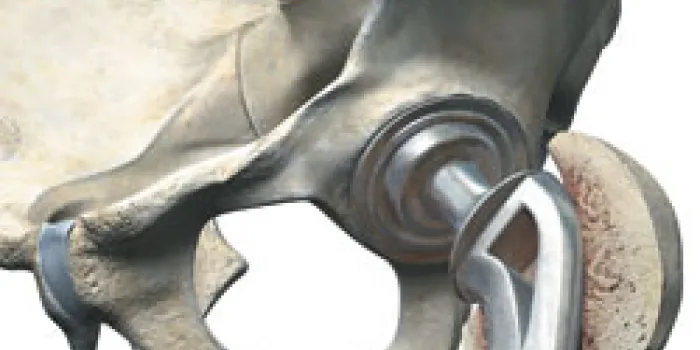Elvis swiveled them. Jeans hug them. People with hemophilia have pain in them. Hips. Without them, we couldn’t walk or stand. But when hips hurt, life can slow to a crawl. “My right hip had always been painful at times,” says Milton Wilson, 62, who has mild hemophilia B. “But when I was in my early 60s, I was babying it so much that I would find a comfortable position and just sit.” Wilson is the pastor of the Parker City (Indiana) Church of the Nazarene and a night watchman at Youth Opportunity Center of Muncie, a residential treatment facility for at-risk youth.
Hip replacement surgeries, a common joint replacement procedure among the general population, are not performed frequently in people with hemophilia. Unlike other joints, hips do not typically sustain frequent bleeds. Instead, they tend to deteriorate from other causes. Now that men with hemophilia are living longer, they are prone to health concerns of aging, including arthritis in their hips.
Persistent hip joint pain and impaired mobility send the patient to the provider. “The therapist at the Indiana Hemophilia and Thrombosis Center saw my limited motion and encouraged me to get in touch with a surgeon,” Wilson says. Tests and scans revealed the extent of the damage to his right hip. The surgeon told him, “When you want the surgery, you’ll know it’s time.” That was in 2007.
A year later, Wilson was taking pain medications to get through the day. He couldn’t engage in the activities he calls his “forte”—mowing his lawn and shoveling snow. “That old hip had become my life,” he says. It was time. Wilson had total hip replacement surgery on July 9, 2008.
The Hip Joint
The hip is a ball-and-socket joint. The rounded head of the femur, the long bone of the thigh, fits into the cup-shaped depression in the acetabulum, part of the pelvis. Cartilage on their surfaces acts as a shock absorber, cushioning the bones and helping them move smoothly. Synovial fluid, produced by the synovial membrane surrounding the joint, keeps it lubricated and helps minimize friction.
But hips can take a hit. For Wilson, it was an accident when he was 13 years old. “I fell off a horse onto the frozen ground. Oh, it hurt so much,” he recalls. “It was not a debilitating injury, but apparently got things set off in the wrong direction.” Such traumatic arthritis can lead to long-term osteoarthritis.
“It’s a progressive deterioration,” says Jerome Wiedel, MD, retired orthopedic surgeon at the University of Colorado Health Sciences Center in Aurora. “Eventually the cartilage is destroyed and patients have fairly advanced degenerative disease in the joint.” Without cartilage, the hip bones rub, causing pain and stiffness.
Other hip disorders found in people without hemophilia can also affect this community. Infants with hemophilia can be born with hip dysplasia, which causes the joint to dislocate easily because the ligaments surrounding it are loose or stretched. Although difficult to diagnose because there is minimal pain, hip dysplasia becomes a problem during puberty, when a child becomes more active. It can result in different leg lengths, a ducklike gait or arthritis. The condition is so pervasive—it is the most common congenital defect in newborns—that some doctors are calling for routine screening of high-risk newborns.
Avascular necrosis, or osteonecrosis, can also destroy the hip joint. “It can result from acute bleeding episodes in the hip joint,” Wiedel says. While the condition is rare, it has occurred in patients with hemophilia. “Pressure builds up in the joint, compromising circulation, which then leads to avascular necrosis.” Without blood to nourish the head of the femur, it collapses and can die. The misshapen ball then does not fit in the socket and the joint wears out.
Synovitis occurs when the blood irritates the synovium, causing it to become inflamed and thicken, making it more susceptible to future bleeding and swelling. Synovectomy, a procedure to remove the damaged synovial membrane, is not commonly done in the hip. “Hemophilic bleeding episodes in the hip are so infrequent that it’s never been an issue of doing early synovectomies, as we do in the ankles, knees and elbows,” Wiedel says.
Proactively Preparing for Surgery
Candidates for hip replacements for people with bleeding disorders can range from young adults to middle-aged men. “The majority of hip replacements are a bit older than the knee replacement patients, more commonly in their 50s and 60s,” Wiedel says.
The decision to undergo hip replacement surgery should be made after consulting the staff at your hemophilia treatment center (HTC) and an orthopedic surgeon who is familiar with patients with bleeding disorders.
Not all patients with hip issues are automatically encouraged to have surgery. “It is important to have a physical therapist help you decide if it’s going to work for you,” says Pattye Tobase, PT, DPT, OCS, University of California San Francisco Hemophilia Program. “We have to consider the state of their elbows and shoulders, because they will be using crutches and a walker. Because of the weight-bearing on other joints, we have to see how it is going to affect their ankles, especially if they have fused or arthritic ankles.”
Prior to the surgery, an orthopedic evaluation is done. The patient’s medical history is taken, with emphasis on the extent of hip pain and loss of function. A physical exam reveals how much mobility and strength have been lost and how the alignment has been affected. X-rays show the extent of damage to the bone, while an MRI can show the condition of soft tissue. Blood tests and bone scans may also be ordered.
Hip replacements come with a long list of post-op precautions during the first six to eight weeks to prevent the joint from dislocating while the hip muscles that were cut and stretched heal, says Tobase. “They are not to bend that hip more than 90 degrees. A guideline we use is not to have your knee above your hip when you sit,” she says. Another is to refrain from crossing the legs or ankles. A third is to avoid turning the feet inward.

Prior to the surgery, Wilson bought a lift chair and some “reachers” to grab things on high shelves. “They taught me how to put my shoes on, and I had a sock puller,” he says. “They had me all ready before the surgery on the no-nos.”
Handrails on stairways and safety bars in the shower also help. A caregiver will be necessary during the initial recovery to help with cooking, shopping, bathing and other daily activities. Wilson, a father of five adult children, relied on a visiting nurse and one of his daughters during his recovery at home. “Spiritually, it was a blessing having their help,” he says. “I was needing the assurance of the love of my family and church.”
Time for the Surgery
In total hip replacement surgery, or hip arthroplasty, the damaged ball and socket—the head of the femur, cartilage and other bone—are removed and new replacement components inserted. “The femoral prosthesis has a stem that goes down into the femur. Then the artificial ball is sized accordingly and placed on that prosthesis,” Wiedel says. “It, in turn, articulates with the new socket, which is relined.”
To cement or not to cement the components to the bone? That is the question. “It can be done both ways, but doing it without the cement is probably the preferred method for the hip joint,” Wiedel says. “The surface of the prosthesis is treated with a type of metal that is press-fit into the bone. Then the bone grows into the surface and anchors this prosthesis.”
Typical materials for the ball are a highly polished strong metal, such as a cobalt chrome alloy, or ceramic, both of which work well where there are rubbing surfaces that create friction, says Wiedel. The metal stem is usually titanium. The socket is a metal shell with a similar porous surface for bone ingrowth. Options for the socket liner are plastic, metal or ceramic.
Each of these materials has advantages and disadvantages. “The surgeon has to determine with the patient which is more appropriate,” Wiedel says. When he started performing hip replacements 30 years ago, the plastic materials wore out within 15 years. Now, patients can expect up to twice that longevity. “Today, both the plastic materials and these hard-bearing surfaces should allow a joint to last beyond that time and possibly go indefinitely,” he says.
Keeping a high factor level in the bloodstream is a top concern for a hip replacement surgery. During the operation, the factor level is maintained at 100% and is kept very high for the first week to 10 days to control the bleeding, Wiedel says.
All surgeries have a risk of infection; for joint replacements, it comes later. “The post-op infection rate is not greater than in a person without hemophilia. It’s the long-term risk of infection that we worry about with any prosthesis,” Wiedel says. Infection can arise because of poor hygiene during self-infusions or develop in patients who are HIV-positive and immunocompromised.
[Steps for Living: Importance of Hygiene]
Get Moving
“By the third day, I was walking out of my room and around the nurses’ station and back,” says Wilson. “I was also doing exercises in the bed under the direction of the therapist.”
Building strength and restoring movement are the primary goals of post-op PT, Tobase says. “To strengthen the muscles that were cut, we encourage hip abduction, lifting the leg out to the side, which works the hip abductor and gluteal muscles.” Next, Tobase adds isometric exercises, contracting the muscles without moving them. Then she introduces gentle active exercises and functional activities, such as walking. Later, movement exercises with some resistance are added. To regain function, patients practice stair climbing and getting in and out of chairs and the car. Patients end up working all the muscles in the hip.
Most patients spend up to a week in the hospital and go home using crutches or a walker for several weeks. But therapy continues for months. “The amount of therapy depends on the patient’s goals. An outpatient program can last two to six months,” says Tobase. Much depends on how fit and active the patient was before the surgery, the extent of the damage and the patient’s lifestyle. “The physical therapist tailors the exercise or rehab program for that particular individual, to figure out what’s the most effective way for that person to fit this exercise in,” adds Tobase.
Although physical therapy was taxing, Wilson says, it was worth it. For years he had walked with a limp. “It was a challenge to rebuild strength in the right leg. I didn’t really like to stretch those muscles,” he confesses. “But now there is a big difference in my gait.”
An Active Life Again
Patients can expect to return to an active lifestyle with a few restrictions. “I discourage high-impact activities—running, jumping or sports that can lead to potential risk of increasing mechanical problems such as wear,” says Wiedel. “After a hip replacement, though, a person should be able to do all the normal activities of daily life without restrictions.”
Wilson has returned to some of his favorite activities. “If I was going to brag about anything after the surgery, it would be that this year I’ve done all of my own lawn mowing,” he says. “It looks better than it’s ever looked.” Wilson also hoed a plot for a small vegetable garden. Last winter he shoveled some snow.
“I went from terrible pain to no pain,” Wilson says. “If you have an arthritic hip or damaged joint that makes you immobile, get the surgery done.”

